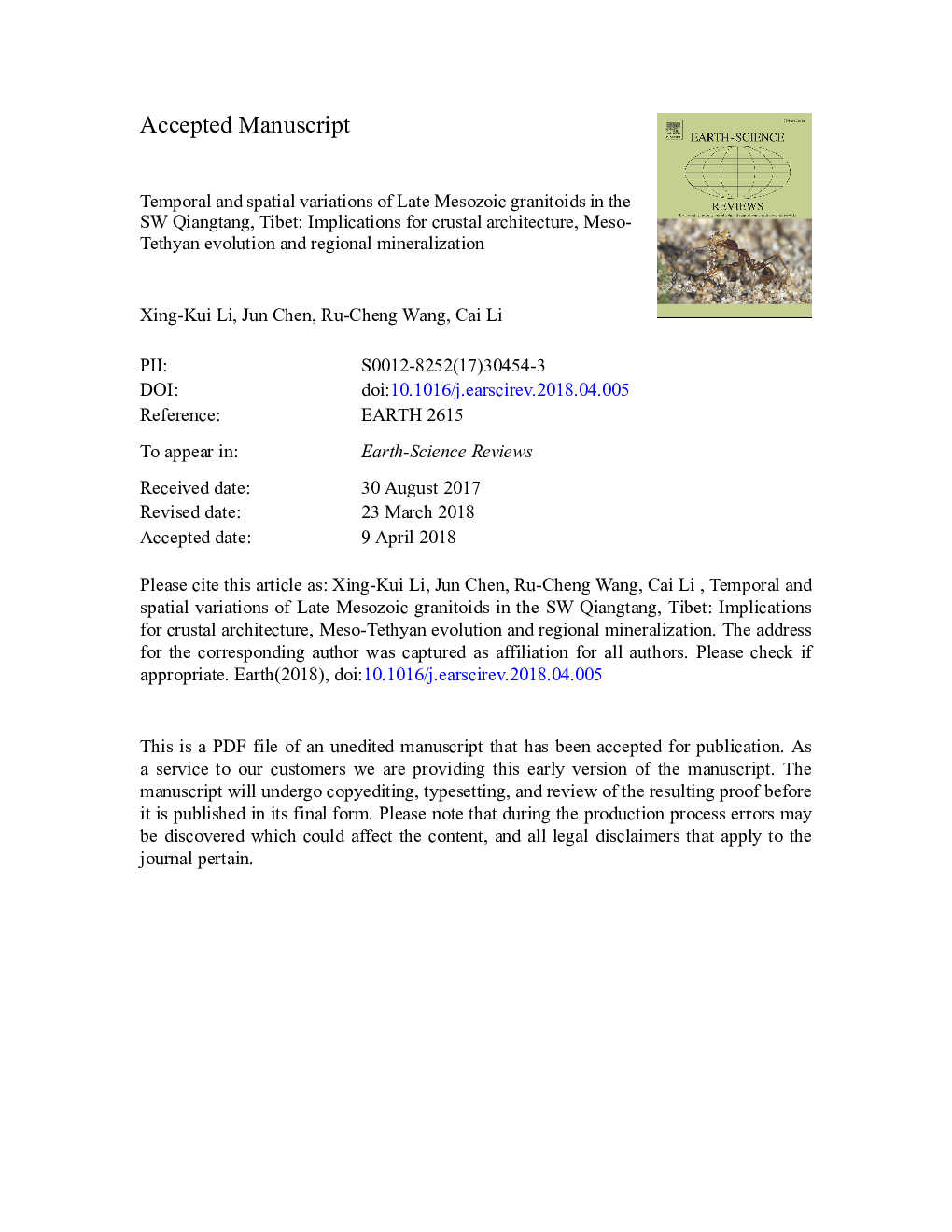| کد مقاله | کد نشریه | سال انتشار | مقاله انگلیسی | نسخه تمام متن |
|---|---|---|---|---|
| 8912887 | 1639918 | 2018 | 91 صفحه PDF | دانلود رایگان |
عنوان انگلیسی مقاله ISI
Temporal and spatial variations of Late Mesozoic granitoids in the SW Qiangtang, Tibet: Implications for crustal architecture, Meso-Tethyan evolution and regional mineralization
دانلود مقاله + سفارش ترجمه
دانلود مقاله ISI انگلیسی
رایگان برای ایرانیان
کلمات کلیدی
موضوعات مرتبط
مهندسی و علوم پایه
علوم زمین و سیارات
زمین شناسی
پیش نمایش صفحه اول مقاله

چکیده انگلیسی
The western segment of the South Qiangtang terrane (W-SQT) is an ideal place to investigate the Late Mesozoic crustal architecture, tectonomagmatic evolution and regional mineralization of this terrane, where the emplacement of voluminous Late Mesozoic granitoids provides favorable conditions to form some world-class porphyry Cu-Au mineral deposits, as well as a series of Fe, Pb-Zn, and W mineral deposits or occurrences. Here we synthesize the spatial distribution, geological, geochronological, geochemical, and isotopic data of the Late Mesozoic granitoids and associated mineral deposits or occurrences in W-SQT. These data suggest that the granitoid magmatism in W-SQT lasted from ca. 170â¯Ma to ca. 110â¯Ma, with two magmatic flare-ups at ca. 170-150â¯Ma and ca. 130-110â¯Ma. In particular, the granitoids formed between ca. 170â¯Ma and ca. 120â¯Ma are generally younger from north to south, indicating a southward migration of magmatism during this period. The compositions of the granitoids vary considerably across W-SQT, becoming more reduced and evolved from the ancient coastal area (i.e., the area close to the Bangong-Nujiang Suture Zone) to the continental interior area. Moreover, the zircon εHf(t) values of the granitoids also gradually decrease from the ancient coastal area to the interior area, indicating the ancient crustal components in the source of the granitoids increase continentward. We therefore concluded that an ancient crustal basement with Archean to Paleoproterozoic ages must exist beneath the interior of the South Qiangtang terrane, i.e., the South Qiangtang terrane has been an older microcontinent. Based on this conclusion, a comprehensive model involving the flat subduction, break-off, rollback, and complete detachment of the Bangong-Nujiang oceanic slab was proposed for the Late Mesozoic tectonomagmatic and metallogenic evolution of W-SQT. In particular, the thickening of W-SQT crust during Late Jurassic and the occurrence of magmatic gap (ca. 140-130â¯Ma) were interpreted to be associated with the flat subduction of Bangong-Nujiang oceanic slab. The development of regional extension recorded by Early Cretaceous (127-122â¯Ma) mafic dikes and bimodal volcanic rocks, and the southward migration of granitoid magmatism were attributed to the break-off and rollback of Bangong-Nujiang oceanic slab. Our study also shows that the Early Cretaceous mantle-derived (juvenile crust-derived), highly-oxidized and less-evolved granitoids are most favourable for the generation of significant porphyry Cu-Au deposits, while the Middle-Late Jurassic mature crust-derived, relatively-reduced and highly-evolved granitoids are highly prospective for Pb-Zn and W mineralisations. In addition, the granitoids generated by a mixture of mantle-derived and mature crust-derived components have high potential for skarn Fe (Cu) deposits. For the W-SQT magmatic belt as a whole, Cu-Au-prospective granitoids, Fe (Cu)-prospective granitoids, and Pb-Zn-W-prospective granitoids exist in the south, the middle and the north, respectively.
ناشر
Database: Elsevier - ScienceDirect (ساینس دایرکت)
Journal: Earth-Science Reviews - Volume 185, October 2018, Pages 374-396
Journal: Earth-Science Reviews - Volume 185, October 2018, Pages 374-396
نویسندگان
Xing-Kui Li, Jun Chen, Ru-Cheng Wang, Cai Li,